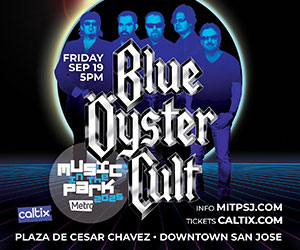 How Santa Cruz’s vibrant culinary scene turned me into a food and wine writer
How Santa Cruz’s vibrant culinary scene turned me into a food and wine writer
Maybe it happened because I’d spent part of my childhood in Europe. By the time I was 12, I’d hit cafes in Como, patisseries in Paris, and weinstubes in Munich. Or maybe it happened because I had no fear. Or both. But at any rate, there came a time in the early days of Santa Cruz alternative journalism, circa 1980-something, that a posh new California-cuisine restaurant opened in the old Cooper House. It was called Hilarie’s and the chef, Ray Pinochi, resembled a thinking woman’s cross between a Hell’s Angel and a Viking god. That worked for me, and so did Pinochi’s menu, which featured lots of nouvelle touches like reduction sauces spiked with Pernod, salads tossed with raspberry vinaigrette, adorable baby vegetables instead of big full-grown everyday vegetables, and beautifully presented seafood and game dishes. It was the era of scallops crowned with prosciutto and wrapped in ribbons of leek. It was the power moment of dining as entertainment, and it seemed like every street corner in Santa Cruz had sprouted a wonderful new restaurant. Some were long on intriguing ethnic menus—Seychelles, The Swan/Heavenly Goose, Zanzibar, China Szechuan, O’mei, India Joze, Persimmon House, Sukeroku. Some gave a California spin to bistros of European and Mediterranean provenance—Salmon Poacher, Theo’s, Casablanca, l’Oustalou, Cedar St. Cafe, Chez Renee, Cafe Sparrow, Primizia, Pearl Alley Bistro, the Courtyard, The Farm, the list goes on and on. Everybody went out to eat. All. The. Time. And the same everybody wanted to know just where to spend their dining dollars. I had some pretty specific ideas on that question.
I went to the opening of Hilarie’s, sampled gorgeous (looking and tasting) appetizers and wrote up an energetic little riff on why people should get extremely excited about Pinochi’s menu. It seems that I had a knack for vibrant, down-to-earth sensory reportage—and it was much more fun than finishing up the dissertation I’d been avoiding.
Around the same time that Hilarie’s opened, a tiny redhead came knocking on the door of Santa Cruz Express. She had a few bottles of chilled chardonnay in her hands and she didn’t hesitate to open them and pour a few glasses for us. We didn’t hesitate to drink them. She was June Smith and the wine she pitched—Roudon-Smith—represented one of the first wave of the new wave of boutique California premiums. But she wasn’t the only surfer on that wave, and pretty soon there were others. Like a tall good-looking guy from Beverly Hills who’d just planted a few very costly clones of Pinot Noir up in the hills of Bonny Doon. His name was Randall Grahm and he could talk about wine, Kierkegaard, and Middle English dialects all day long. I could listen to Grahm all day long. And I did. Pretty soon I was wandering through damp cellars, through forests of steel fermenting tanks, learning to swill and spit into those unfortunately undersized little drains in the concrete floors. Many shoes were stained an indelible shade of Grenache during those arduous early days.
Back then, winemakers pitched their tents on a weekly basis, it seemed. Where Roudon-Smith, David Bruce, Felton-Empire, and Bonny Doon Vineyard led, others joined in. Storrs, Smothers, Byington, Salamandre, McHenry, Silver Mountain. Post-hippie winemakers like Jeff Emery, J.P. Pawloski, Jim Beauregard, Chuck Devlin, Prudy Foxx and John Schumacher brought their wine instincts and sheer grit to the seemingly insane idea of making top-quality wines—initially based on the Burgundian grail of Chardonnay and Pinot Noir—on this rocky, mountainous, coastal neck of the woods.
Nobody likes to talk about their oenolic handiwork like up-and-coming winemakers. Shamans bearing gifts with sturdy tannins and top notes of mint and licorice, they were hugely informative and entertaining. I hung out with them, visited their wine-making facilities—tiny, cramped cellars usually located at the end of steep mountain roads (at least one car radiator was sacrificed in the quest for the latest Syrah). I listened. I tasted. I took notes.
Dexter Ahlgren helped me educate my tastebuds on the distinctions between Sémillon and Sauvignon Blanc. Steve Storrs explained the alchemy of Pinot Noir clones. Bradley Brown taught me to appreciate the crimson blackness of Syrah, and Jim Schultze provided liquid epiphanies on the joys of tannins. Just like the red wine stains in my Levis, some of their lore sank in. Eventually, I learned how to taste, what to taste for, and not only what I liked in wines—almost anything red, if you must know—but what made a wine memorable: minerality, complexity, and a long finish. (Thanks again, Jim Schultze).
Jokes about arduous field work aside, acquiring a grasp for what makes one wine a stand-out and another simply serviceable is a lifelong study. Wine is a living creation, and like everything that’s alive, it changes as it grows, develops, and ages. A glass of wine five minutes after it was opened is a far different creature than the same glass a half hour later. Learning to detect and savor those nuances has come with the territory. I’ve been lucky.
Our winemakers wanted me to get on board with what they were up to just as much as I wanted to sample and appreciate their craft. It was a mutual pact among consenting adults. I think I got the best end of that bargain.
Our local food scene—indeed, the entire California culinary scene—and our Santa Cruz Mountains wine-growing adventure, both came up together. When I began food and wine writing, times were flush; everybody uncorked bottles for plenty of free tastings, and many restaurants were happy to bring out a few extra dishes for me to try. I didn’t have an expense account, but the newspaper did have trade-outs with lots of great eateries, so I could graze, sample, and immerse myself in new dishes and seasonal specialties the minute they arrived on local menus. It was the best of times and the tastiest of times.
Adventurous restaurateurs like Paul Cocking turned the kitchen of Gabriella Cafe into what has become the prequel to many superstar chefs’ careers—Jim Denevan, Rebecca King, Brad Briske, Sean Baker, and Ari Taymor.
I continued to tune my palate by saving my puny salaries (more than one day job has been my lifelong strategy) for trips to Europe and Mexico throughout those prime tasting and dining years. There is nothing like a five-hour dinner at some multi-Michelin-starred restaurant abroad to add nuance to one’s discernment. Accompanied by fellow foodies, such as Rosemary Bryan and Melody Quarnstrom, I ate my way across France, starting in Paris where I had a superb meal at Guy Savoy (before chef Savoy spawned a dining empire on two continents), before heading south to l’Esperance and Paul Bocuse. A passion for Italy has broadened my palate (though not my hips, thanks to nonstop walking), and last year I enjoyed a one star Michelin lunch in Milan, then another in Munich. I try to keep some skin in the game.
The point is that wherever I am—at home or traveling—I make sure to find out what chefs are up to, what the local specialties are like, and what seasonal harvest is being showcased. A few years ago, a trip to Rome in early October produced dish after dish, on menu after menu, of variations on fresh porcini mushrooms. Back home at Ristorante Avanti, I found the local California variations on fresh porcini, as wonderful as they were, not European. My taste buds could compare. I admit I’ve become a food and wine tourist
(OK, and art and opera), finding the cuisine of a region to be one of the most accurate lenses through which to understand the locals, their values and their passions. Let’s just say it has worked for me.
Along the way I won some awards and three James Beard Foundation nominations. And this kind of decades-long research allows me to confidently and genuinely enjoy the many creative food and wine experiences once again on the ascendance in Santa Cruz: a Hungarian wine workshop at Soif, an evening of southern Italian specialties at La Posta, venison carpaccio at Oswald, winter squashes with Szechuan peppercorns at O’mei, shredded baby artichokes and organic arugula at La Gioconda, seafood carpaccio at Bantam, authentic rye breads from Companion Bakeshop. A glass of Pinot Noir made by Tony Craig, un-oaked Chards from Ryan Beauregard, or just about anything concocted by Jeff Emery. Bold and often surprising, such sensory experiences are the continual rewards of a charmed career.
PHOTO:A beautifully executed halibut dish at Ristorante Avanti. CHRISTINA WATERS



















